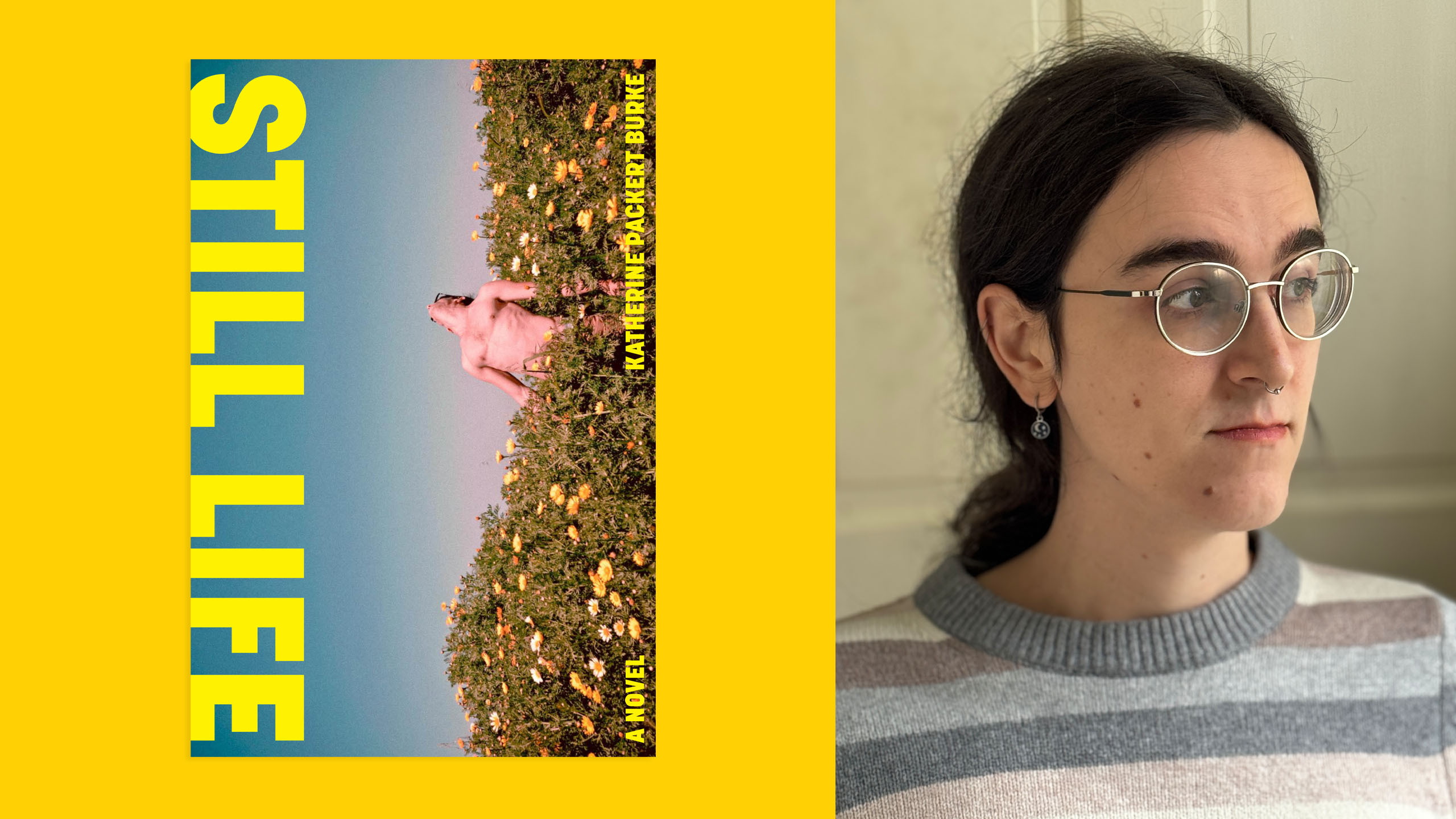Close to the beginning of Katherine Packert Burke’s novel Still Life, its protagonist, Edith McAllister, a twenty-nine-year-old trans writer, is asked by friends about her novel-in-progress. She refuses to tell them about it. “It’s not autofiction, is it?” one of them asks. “No,” Edith responds with a snort. She’s lying: she’s writing a barely fictionalized account of her relationship with her friend Valerie, another trans woman who shepherded Edith through the earliest stages of her transition, became an on-again-off-again lover and died suddenly in a car crash. Valerie’s death punched a hole in Edith’s life that she’s still trying to work through, unsuccessfully, by writing, for nearly a year—the kind of stalled-out work that has three working titles and a meandering, fragmentary draft. At the beginning of Still Life, Edith has started to think of her project, and by extension herself, as a failure, even as the book swallows more and more of her life. She describes it as a “Borgesian map the same size as the territory,” and it starts to implicate not only Valerie but her cis ex-girlfriend Tessa—the two women who understood her best, who both ended up leaving her, one way or another.
Writing fiction is certainly one of the least efficient ways to process emotions, and it might even be counterproductive. Art has its own demands: the kind of work that goes into creating a compelling, coherent piece of writing can be at cross purposes with the kind of work that makes you feel more or less at ease with your own life. There are, of course, particular problems with writing about one’s own life as a trans woman—not only because so much of trans life is disappointing and frustrating, but because reconciling with one’s own pre-transition past is an impossible task, an unbridgeable gap. Burke’s novel—her debut—is a portrait of the struggles and frustrations of becoming a trans writer in the face of these difficulties, as well as the things that make it worth it. As Edith puts it, “There wasn’t another way to the other side of this hurt.” Edith spends most of this meandering, lyrical novel trying, over and over, to break through to this “other side.”
The plot of Still Life is organized around the ordinary turning points of early adulthood—moving to new cities, going to graduate school, breaking up with long-term partners, reuniting with old friends—with only a couple dramatic ruptures. We first see Edith visiting Boston from Texas after an absence of six years, to give a talk at her college friend Adam’s writing workshop. While she’s there, she meets up with Tessa, her ex-girlfriend and best friend from college, who she’s had a chilly relationship with since they broke up, and finds out that Tessa is now engaged to a cis man, which feels to Edith like a betrayal. Disappointed and saddened by her failure to re-establish their friendship, Edith returns to Texas, where she needs to come to some kind of decision about the book she’s writing, and what she’s going to do with her life. Threaded through this narrative in the present are chapters that flash back to Edith’s recent past, which show her friendships with Tessa and Valerie, her post-graduate failed relationship with Tessa in Boston and, later, her romantic relationship with Valerie, who persuaded her to transition and whose unpredictability and restlessness cemented Edith’s loneliness, even before she died unexpectedly.
The way Burke juxtaposes these two timelines suggests irresolution: the flashbacks are Edith’s memories, still poignant and alive—they are also a catalogue of regrets, paths untaken, lost happiness. In particular, Edith seems to wish that she could reclaim her college life, where she and Tessa and Valerie were as inseparable as sitcom characters, with the kind of mind-melding friendship that is maybe only possible when everyone involved is nineteen years old. The flashbacks of their college life together are told in a breathless montage of sepia-toned snapshots: we see the trio comforting each other after breakups, teasing each other, going to parties together, crashing on each other’s floors and making each other breakfast. The mismatch between their sexual and gender identities—Tessa is a cis lesbian, Valerie is a bisexual trans woman and Edith, at that time, is still cis and straight (Burke only ever uses Edith’s present-day name and pronouns for the flashbacks)—doesn’t seem to matter at all.
We see, in the present-day timeline, how distant that world has become for Edith. Her relationship with Tessa moved over time from a place of easy mutual understanding to a suffocating closeness that ended in a prolonged breakup—and Valerie’s death further breaks something in their friendship. In Boston, when Edith meets with an inevitably more grown-up Tessa, she’s confronted with a strange sense of déjà vu, “like being thrust into the second act of a play,” Edith thinks ruefully. “Now the boy is played by a girl.” Their rapport has faded and their conversation is awkward, burdened with omissions and silences, particularly surrounding the now-absent Valerie. They’ve drifted apart, and Edith sees this as a missed opportunity, even as it’s clear that Tessa has moved on.
Regret saturates Edith’s inner monologue—her visit to Boston, and especially her meeting with Tessa, represents to her “all the eventualities she’d removed herself from.” We start to realize that Edith’s regret is one of the things getting in the way of her writing. To wish that your life had gone another way is to fail to come to terms with what it actually is; when we see Edith thinking things like “[she] couldn’t tell stories about her own life when she understood it so poorly,” what she’s really doing is evading herself. What she longs for is a kind of settled, monogamous closeness, an uncomplicated happiness, which she feels locked out of now—partly because of her transition, partly because of what feels to her like some nagging, innate flaw.
After the fateful meeting with Tessa, she gives a wildly off-script talk to Adam’s class of writing students:
“What I learned writing a book is the same thing I learned becoming a girl: you still have to wake up every day and be the person you are. And now you don’t have the promise of being fixed by some future choice you’ve been waiting to make.… So you keep on searching for new things, or waiting for the old things to work in ways they never have, and then one day you’re twenty-nine years old and your ex-girlfriend is calling you to tell you that your other ex-girlfriend—if she counts, if she ever loved you in a way that matters—has died.”
Writing hasn’t saved Edith in the exact same way that transition hasn’t saved her, because people are never saved.
The first half of the novel is heavily freighted with Edith’s past: once she goes back to Texas, we get to see the queer adulthood she’s built for herself in its wake. The plot gets anecdotal and loose. Edith attends queer house parties and trans rights protests and goes on a bunch of unsatisfying dates with men. Essayistic passages on Sondheim musicals and Gossip Girl are interspersed more often in the text. Many colourful side characters are introduced, each with their own set of reasons of why they get on Edith’s nerves. We get the sense that Edith is working toward something, growing up a little, even if she’s still a bit of a mess. She’s taking stock of herself, trying to move on.
Late in the novel, we learn that Edith developed a love for autofiction from Valerie, who recommended authors such as Ben Lerner, Kate Zambreno and Sheila Heti to her. Thinking about her, Edith rereads these books and has a small, but real breakthrough. “Writing about life is antithetical to living and vice versa,” Edith thinks. “You must empty out certain parts, must fill those gaps with something else.”
Still Life has a lot in common with Heti, Lerner, and Zambreno stylistically, with its essayistic passages on art and the close conjoinment of life and the writing of it. Another thing that Burke’s novel has in common with these writers is that it is about how little one can really understand about one’s own life while in the middle of living it—that life is never solved, but that accepting this brings a kind of resolution. Shortly after Edith’s small breakthrough, we see her abandon her project about Valerie—an attempt to capture some essential, ineffable truth of their relationship and her death—and we see her, while packing up her apartment, begin to write the first sentences of Still Life, the novel we are reading, a kind of metafictional fourth-wall break that also serves as the first real, albeit small, triumph for Edith. She has learned that it’s better to linger in irresolution than to strain under the compulsion to squeeze her life into a false coherence.
Torrey Peters once wrote that “paradoxically, for members of a group as marginalized as trans people, fiction frees writers to safely tell the truth.” This freedom is what Edith discovers. Burke’s novel rings true to my own reasons for writing fiction as a trans woman: fiction is a way of getting everything on paper, including the mistakes and missteps; the discomfort of leaving a life story filled with holes and blurry bits, events that fail to foreshadow and even the persistent, nagging sense of having lived a wrong life. It holds out the possibility, not of redeeming this material, but of giving it its own kind of dignity; it wagers that acceptance is more powerful than shame.


 Why you can trust Xtra
Why you can trust Xtra


